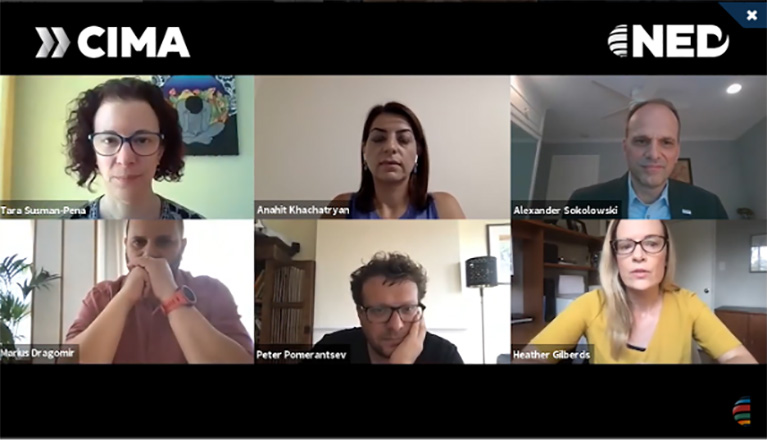The power of data for media development: Panelists discuss the Vibrant Information Barometer

The Vibrant Information Barometer (VIBE) offers a new way of tracking and analyzing media and information trends that are reshaping societies. How can donor organizations, development implementers, media organizations, and others use the data to create positive change?
Information production and consumption have drastically changed over the past two decades: Before the growth of the internet and before social media and smartphones became ubiquitous, traditional media organizations played the largest role in producing information that individuals consumed. Today, however, people around the world simultaneously produce, transmit, consume, and act on information, which in turn shapes their environment and their lives.
To analyze these trends and identify the challenges and opportunities of today’s complex information systems, we recently published our first USAID-funded Europe and Eurasia Vibrant Information Barometer study.
We presented the study at a panel event, The Power of Data: A New Way to Measure International Media Development, hosted by the National Endowment for Democracy’s Center for International Media Assistance (CIMA) on July 15, 2021.
The event introduced VIBE’s methodology and main findings to 70 attendees. Speakers included Marius Dragomir (director at the Center for Media, Data, and Society), Anahit Khachatryan (democracy, rights, and governance advisor at USAID/Armenia), Peter Pomerantsev (senior fellow at the Johns Hopkins Stavros Niarchos Foundation Agora Institute), and Tara Susman-Peña (senior technical expert at IREX). Heather Gilberds (associate director and editor at CIMA) moderated the discussion.
How the Vibrant Information Barometer works
VIBE builds on IREX’s nearly 20 years of experience in producing the USAID-funded Media Sustainability Index (MSI). VIBE provides an updated framework that measures information spheres in the digital age by examining four principles of information vibrancy:
- Information quality
- Information flows
- Information consumption and engagement
- Information’s ability to drive behavior
VIBE functions as a measurement tool, as an instrument to guide media development assistance, and as research that contributes to emerging issues.
VIBE’s approach brings together diverse expert panelists from the media, information, and civil society sectors at local, regional, and national levels. Country-based media and information experts moderate local panels and integrate these discussions with information from panelists’ detailed questionnaires to produce narrative country chapters. To supplement these narratives, we developed a dashboard, the VIBE Explorer, which allows users to compare country scores and analyze trends at the country, principle, and indicator levels.
A way to measure disinformation, media literacy, and other factors across numerous channels
Developing VIBE helped us think about how to examine new and emerging concepts, such as hate speech on social media, disinformation and other forms of manipulation, and the media’s role in revealing corruption and human rights violations in new ways.
Susman-Peña explained that while VIBE’s predecessor, the Media Sustainability Index, examined the plurality of new sources in the formal media sector, the MSI did not focus on whether the new sources of news and information improved the overall quality of the information ecosystem. VIBE was designed to answer precisely this type of question.
For example, we consistently found that people in all 13 European and Eurasian countries that VIBE covered had high levels of access to information. However, to balance and contextualize this, VIBE assessed indicators on disinformation, media literacy, and other concepts to measure the quality of information and determine how well consumers distinguish between reliable information and misinformation.
Opportunities for analyzing, presenting, and applying the findings
During the event, speakers often brought up the need to highlight how supporting independent media directly connects to supporting democracy. Alexander Sokolowski, deputy assistant administrator of USAID’s Bureau for Europe and Eurasia, discussed how VIBE’s data on how information drives behavior can highlight that societies with authoritarian governments have fewer healthy debates and informed citizens—and more division. Pomerantsev added that security is weak in polarized societies that are rife with disinformation, which can foster the rise of extremism.
Sokolowski further observed that for donors, MSI and VIBE are development tools that track trends across time and make comparisons across countries. Khachatryan shared that in Armenia there has been a proliferation of nontraditional information channels like Telegram. She explained that media outlets may pick up information from these informal channels, which can lend credibility to unverified information. Tools like VIBE can capture these complexities, identify entry points for assistance, and justify complex program responses.
Khachatryan explained that USAID/Armenia often looks to reports like the MSI and VIBE for contextual analysis, and for quotes and anecdotal evidence that come from VIBE panelists, which are often representatives of organizations or outlets they are working with.
Speakers were positive about VIBE’s potential to influence policy on a national and regional level. They repeatedly recognized that consistently funded tools that identify regional trends and comparative statistics between nations have been effective as high-level advocacy tools.
The event provided a first glimpse into how VIBE can be used as a tool to increase impact in development. As IREX continues to produce VIBE, we look forward to learning more about how development professionals and local actors use the narrative reports and data.
The 2021 VIBE study covers 13 countries across Europe and Eurasia (Albania, Armenia, Azerbaijan, Belarus, Bosnia & Herzegovina, Georgia, Kosovo, Moldova, Montenegro, North Macedonia, Russia, Serbia, and Ukraine). VIBE is made possible by the support of the American people through the U.S. Agency for International Development (USAID).